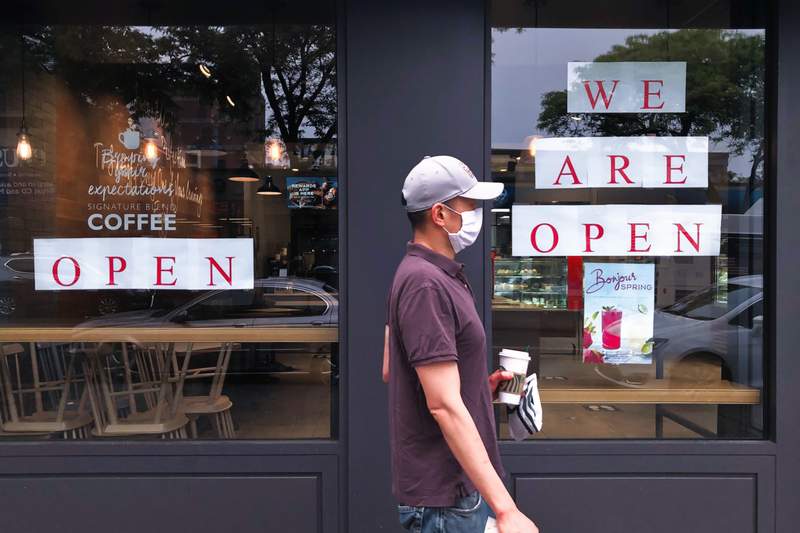
By Geoffrey Smith
Investing.com — A surge in new cases of coronavirus in the U.S. leads to New York imposing a quarantine on out-of-state arrivals, while a closely-watched academic model raises its forecast for the U.S. death toll to 180,000 by October. That’s putting the skids under stocks, which are struggling to bounce from Wednesday’s sell-off, the worst in two weeks. Markets face a challenge from the release of the weekly jobless claims reports and first-quarter GDP. It’s also putting the skids under oil and even gold. Meanwhile in Europe, payments company Wirecard becomes the first-ever DAX member to file for bankruptcy, but Lufthansa averts the same fate after shareholders accept the terms of a government bailout. Here’s what you need to know in financial markets on Thursday, June 25th.
1. U.S. epidemic spirals out of control again
The U.S. recorded over 34,000 new cases of Covid-19, approaching levels last seen at the high point of the epidemic in April.
New York, Connecticut and New Jersey to impose a 14-day quarantine on visitors arriving from the worst-affected states, a new development given that the U.S. had only previously imposed such restrictions on arrivals from abroad.
Florida and Texas both reported record new case numbers, while officials in Houston said that the city’s intensive care facilities would be maxed out today.
The University of Washington in Seattle raised its forecast for the U.S. death toll to 180,000 by October from around 122,000 currently.
2. Jobless claims, GDP, Durable Goods data all due
The U.S. will present its weekly figures for initial and continuing jobless claims at 8:30 AM ET (1230 GMT), with the number of new again expected to have fallen only marginally to 1.30 million, from 1.508 million a week earlier.
are expected to have fallen below 20 million for the first time since April – but that was also true ahead of the previous week’s report.
The government will also announce revisions to its estimate of first-quarter . The number is of largely historical interest, given that the coronavirus barely touched the U.S. economy in March. for May, to be released at the same time, will be more up-to-date information on the state of the economy, but will also be subject to high short-term volatility.
3. Stocks set to open mixed; Fed stress tests eyed
U.S. stock markets are set to open mixed after suffering their worst day since June 11 in response to the surge in Covid-19 cases across much of the country.
By 6:30 AM ET (1030 GMT), the contract was down 106 points or 0.4%, while the contract was down 0.3% and the contract was outperforming modestly, being up less than 0.1%.
Stocks in focus on Thursday will include the banks, who face the results of the Fed’s annual stress tests later in the day. The open question is whether the likelihood of a rise in bad loans due to the pandemic leads the Fed to impose restrictions on shareholder payouts and staff bonuses.
There will also be quarterly updates from JC Penney (OTC:), currently negotiating its way through Chapter 11 proceedings, and – after the closing bell – Nike (NYSE:).
4. Wirecard succumbs, while Lufthansa accepts bailout
German payments company Wirecard said it had filed for bankruptcy protection, three days after admitting to a $2.1 billion hole in its accounts.
The move anticipated the likely cancellations of key partnerships with companies such as Visa (NYSE:), Mastercard (NYSE:) and JCB after the exposure of what appears to have been massive fraud. Former CEO Markus Braun was arrested and released on bail earlier this week.
Wirecard, once a darling of both retail and institutional investors, had joined the benchmark in 2018, forcing out Commerzbank (DE:) in a what struck many as a sign of the times. It’s the first sitting member of the DAX to file for bankruptcy.
Another German ‘champion’, however, avoided the same fate on Wednesday as Lufthansa (DE:) shareholders swung behind a 9 billion euro government-sponsored bailout.
5. Risk-aversion pushes dollar high, commodities lower
The rise in risk-aversion prompted by the fears of a new wave of lockdowns pushed the dollar higher and commodities lower.
By 6:30 AM, the , which tracks the greenback against a basket of developed-market peers, was up 0.2% at 97.34, only 0.2% away from what would be its high for the month. However, its biggest gains came as bounces from oversold levels against the safe haven yen and Swiss franc.
oil prices, by contrast, fell 1.0% to $37.61 a barrel and are down some 7.5% from the highs they hit earlier in the week on hopes that the physical crude market is rebalancing. futures fell 0.7% to hold just above the $40 a barrel mark.
, meanwhile, fell 0.4% to $1,768.50, again underlining a higher correlation to risk assets as it assumes a greater part in leveraged retail portfolios that are susceptible to short-term pressure in equities.




0 Comments:
Post a Comment